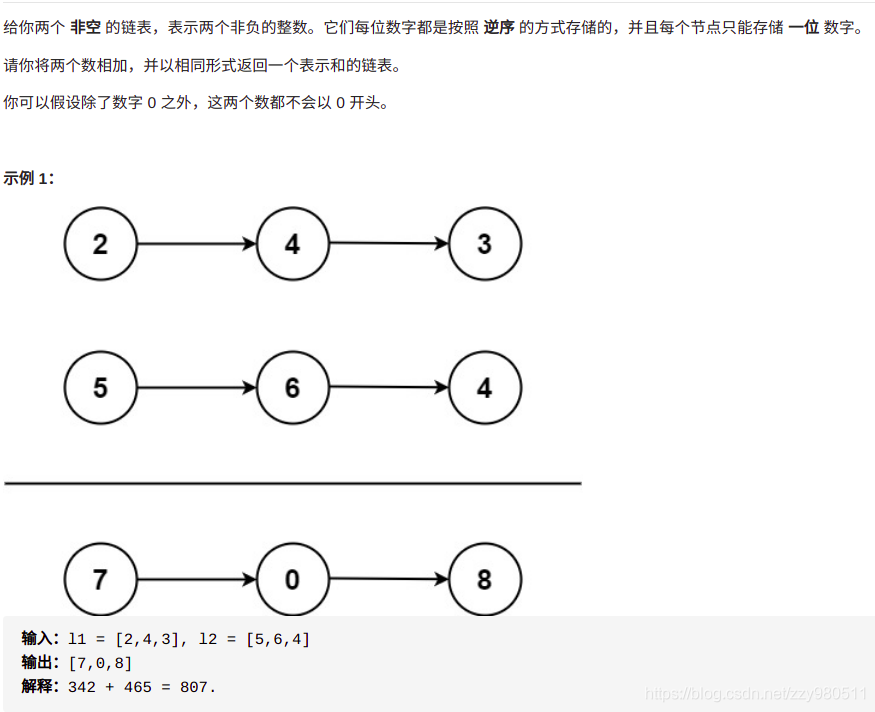当前位置:网站首页>LeetCode160 & LeetCode141——double pointers to solve the linked list
LeetCode160 & LeetCode141——double pointers to solve the linked list
2022-07-22 20:25:00 【Zheyuan Zou】
Summarize two algorithm problems about linked lists at one time , These two problems are solved with Speed pointer The basic idea of . in fact , The problem of loop in the linked list is often inseparable from the fast and slow pointer solution , So we should establish this reflection of thinking .
The first is the intersecting linked list , seeing the name of a thing one thinks of its function , This problem is to judge whether the two linked lists are unified after a certain node , The questions are as follows :
In fact, if you analyze it carefully , It can be found that the difficulty of this problem is that if there is really an intersection in the two linked lists , They are There is no length of the part before the intersection Is not uniform , And we're not sure how much difference there is between the two , The pointer running at the same speed will inevitably miss this intersection . So the starting point of the final solution of this problem is Artificially flatten the distance between them , So that when two pointers with the same speed starting from the heads of the two linked lists meet ( If you can ) The journey is the same , In this case, it can be concluded that : If two linked lists do intersect , There must be some intersection , At this intersection, the two pointers passing through the distance balance will definitely meet , This is the solution to the whole problem .
So how to level the distance artificially ? The way is : Let from the linked list A The pointer whose head starts to move is walking through the linked list A Then start from the linked list B Your head starts moving again , On the contrary, the same . In this way, the length gap between the two linked lists is filled . If two linked lists don't intersect , It can be concluded that if there is no intersection when any pointer reaches the end of its list for the second time , Then you can jump out of the loop and assert that the search failed , Because if there were really intersections, they would have intersected before .
Here is the code I wrote , For coding convenience , I wrote one shiftTrack Function to help pointer convert linked list tracks ,bool The return value indicates whether the conversion is successful , In fact, you are judging whether the search fails . For each pointer , There is one pair To record its information ,first The element records the head of the linked list from which it starts ,0 Express A Linked list ,1 Express B Linked list ;second The element indicates whether it has been converted before , This is an important basis for judging whether the search fails .
bool shiftTrack(ListNode*& Ptr, pair<bool, bool>& Flag, ListNode *headA, ListNode *headB)
{
/*if the present pointer has not been on another track*/
if(Flag.second == 0)
{
/*Ptr1*/
if(Flag.first == 0)
Ptr = headB;
/*Ptr2*/
else
Ptr = headA;
Flag.second = 1;
return true;
}
return false;
}
Then the main program code , It uses while true…break Design example .
ListNode *getIntersectionNode(ListNode *headA, ListNode *headB) {
/*declare 2 pointers*/
ListNode* Ptr1 = headA;
ListNode* Ptr2 = headB;
/*success flag*/
bool Success = false;
/*the first element indicating which one the pointer is*/
/*the second element indicating whether the pointer has been on another track*/
pair<bool, bool> Flag1 = make_pair(0, 0);
pair<bool, bool> Flag2 = make_pair(1, 0);
while(true)
{
/*if the intersection point is founded, jump out of loop*/
if(Ptr1 == Ptr2)
{
Success = true;
break;
}
else
{
/*modify the pointer to next position*/
if(Ptr1->next != nullptr)
Ptr1 = Ptr1->next;
else if(!shiftTrack(Ptr1, Flag1, headA, headB))
break;
if(Ptr2->next != nullptr)
Ptr2 = Ptr2->next;
else if(!shiftTrack(Ptr2, Flag2, headA, headB))
break;
}
}
if(Success)
return Ptr1;
else
return nullptr;
}
This is an overview of using fast and slow pointer algorithm to solve the intersection problem of two linked lists . similarly , There is also the following question , This problem does not involve two linked lists , It is Judge whether there is a loop inside a linked list :
This problem also uses two pointers , The difference is that these two pointers are artificially Exercise at different rates . The principle is simple , It's like running on the school playground , One runs fast and the other runs slowly , Such a fast runner will repeatedly catch up with a slow runner , This proves from the side that the runway is circular , Otherwise, it is impossible to catch up .
So the key point of this question is , Let the two pointers run at different speeds , If there is a self ring , The fast pointer will catch up with the slow pointer , When you meet, you can assert that there is a loop in the linked list , If you reach the end of the list, there is no self ring , That is, there is no self ring . The first is to realize Take a step forward Function of oneStepForward:
bool oneStepForward(ListNode*& Ptr)
{
/*if the next position is null, return false*/
if(Ptr == nullptr || Ptr->next == nullptr)
return false;
/*switch to the next position*/
Ptr = Ptr->next;
return true;
}
And then there was Take two steps forward Function of twoStepForward, through oneStepForward To achieve :
bool twoStepForward(ListNode*& Ptr)
{
/*implement the function through oneStepForward*/
if(!oneStepForward(Ptr) || !oneStepForward(Ptr))
return false;
return true;
}
Then is the logical implementation of the main algorithm :
bool hasCycle(ListNode *head) {
/*if the list is null...*/
if(head == nullptr)
return false;
/*declare 2 pointers here, let 1 pointer chase another 1 */
ListNode* Fast = head->next;
ListNode* Slow = head;
while(true)
{
if(Fast != Slow)
if(!oneStepForward(Slow) || !twoStepForward(Fast))
return false;
else continue;
else
return true;
}
}
边栏推荐
- What does Baidu snapshot hijacking mean? How to solve Baidu snapshot hijacking and Baidu hijacking
- 《预训练周刊》第39期: 深度模型、提示学习
- 她力量系列三丨把握当下,坚持热爱,与食物图像识别结缘的科研之路
- What is network hijacking? How to repair web pages that have been tampered with and hijacked (final scheme) how to repair web page hijacking?
- dns被劫持有什么现象?DNS是什么 dns被劫持了如何解决
- 出现Permission denied的解决办法
- Chinese search for introduction to elastic search (8)
- Leetcode 209. subarray with the smallest length
- Leetcode 21. merge two ordered linked lists
- CPU亲和力
猜你喜欢

高速ADC测试心得

Don't hack the website. How to solve it? How to deal with the problem of website being hacked

LeetCode146——LRU Cache——DS Design

Leetcode0002——Add Two Numbers——Linked List

Getting started with CSDN markdown editor

常见的网站被黑被劫持的手段有哪些?dns劫持工具有那些?

What is the meaning of DNS hijacking, the principle of DNS hijacking and several solutions

Websites jump inexplicably. What is website hijacking from Baidu? How to solve Baidu snapshot hijacking

她力量系列四丨读博6年两次换导师,靠一点点“倔”,俞舟成为social chatbot的开拓者之一

网站安全之域名被劫持、域名被劫持后该怎么办!!!
随机推荐
JNI 数据类型用法
DNS劫持如何预防、DNS是什么?DNS劫持详解
On the horizontal trigger and edge trigger of epoll
SSM框架整合
Getting started with CSDN markdown editor
How to prevent DNS hijacking and what is DNS? DNS hijacking details
信号量实现同步互斥经典案例
Chinese search for introduction to elastic search (8)
redis集群搭建
What is the phenomenon of DNS being hijacked? What is DNS? How to solve DNS hijacking
她力量系列八丨陈丹琦:我希望女生能够得到更多的机会,男生和女生之间的gap会逐渐不存在的
iptables实现负载均衡
Spark data search
Introduction to machine learning: topic model-4
Usage and precautions of accumulator used in spark
Class template parsing
常见的网站被黑被劫持的手段有哪些?dns劫持工具有那些?
How to repair DNS hijacking perfectly? How to solve DNS hijacking and how to repair it perfectly
Introduction to machine learning: Logistic regression-2
LeetCode0003——longest substring without repeating characters——Sliding Window